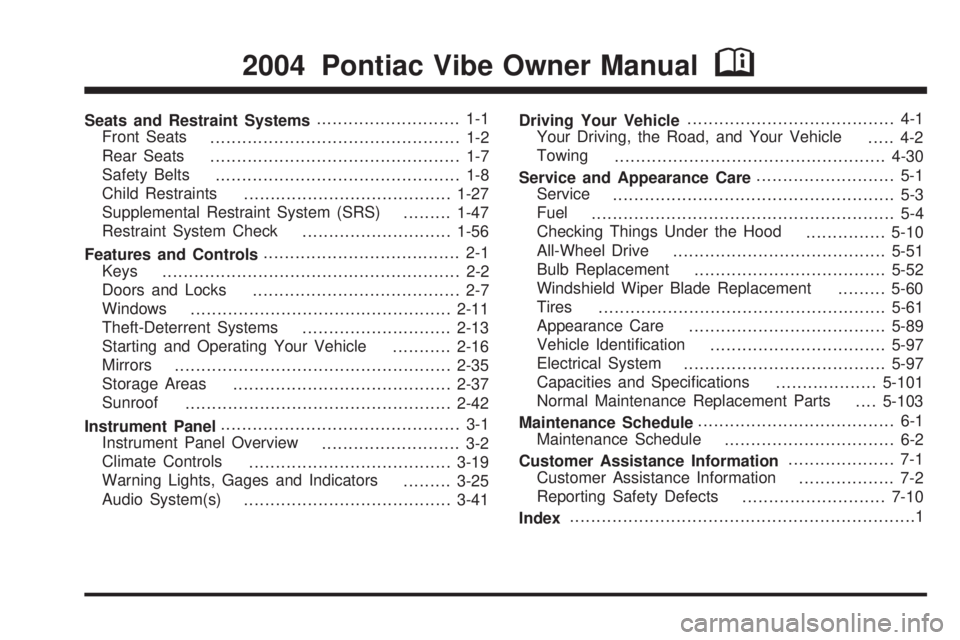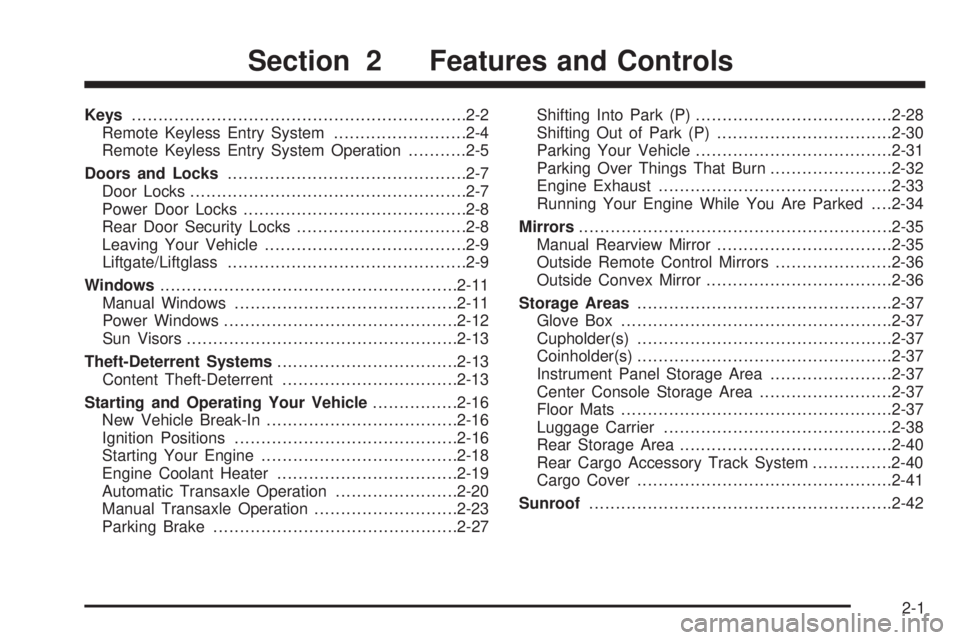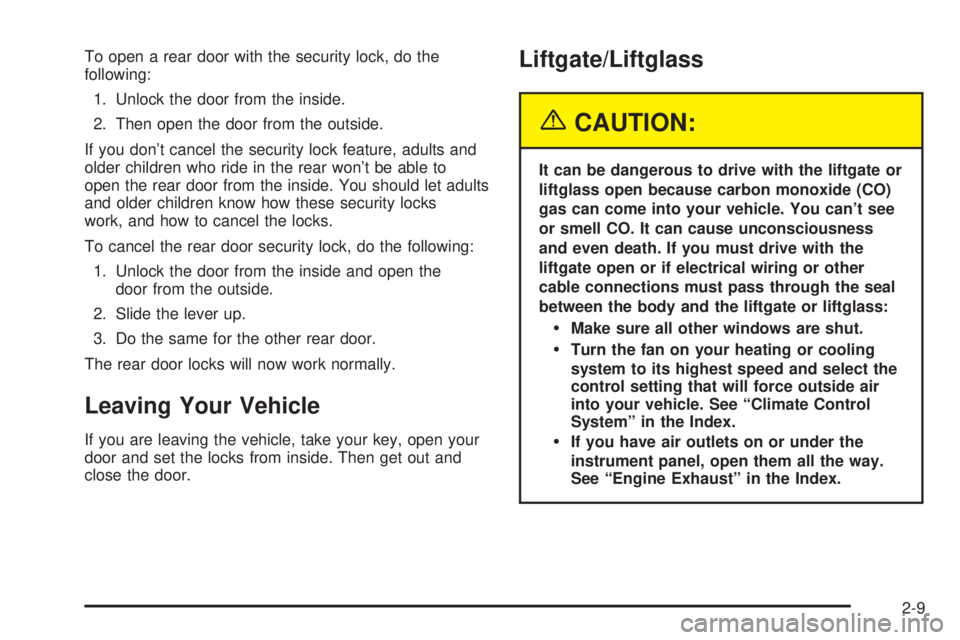window PONTIAC VIBE 2004 Owners Manual
[x] Cancel search | Manufacturer: PONTIAC, Model Year: 2004, Model line: VIBE, Model: PONTIAC VIBE 2004Pages: 370, PDF Size: 2.68 MB
Page 1 of 370

Seats and Restraint Systems........................... 1-1
Front Seats
............................................... 1-2
Rear Seats
............................................... 1-7
Safety Belts
.............................................. 1-8
Child Restraints
.......................................1-27
Supplemental Restraint System (SRS)
.........1-47
Restraint System Check
............................1-56
Features and Controls..................................... 2-1
Keys
........................................................ 2-2
Doors and Locks
....................................... 2-7
Windows
.................................................2-11
Theft-Deterrent Systems
............................2-13
Starting and Operating Your Vehicle
...........2-16
Mirrors
....................................................2-35
Storage Areas
.........................................2-37
Sunroof
..................................................2-42
Instrument Panel............................................. 3-1
Instrument Panel Overview
.......................... 3-2
Climate Controls
......................................3-19
Warning Lights, Gages and Indicators
.........3-25
Audio System(s)
.......................................3-41Driving Your Vehicle....................................... 4-1
Your Driving, the Road, and Your Vehicle
..... 4-2
Towing
...................................................4-30
Service and Appearance Care.......................... 5-1
Service
..................................................... 5-3
Fuel
......................................................... 5-4
Checking Things Under the Hood
...............5-10
All-Wheel Drive
........................................5-51
Bulb Replacement
....................................5-52
Windshield Wiper Blade Replacement
.........5-60
Tires
......................................................5-61
Appearance Care
.....................................5-89
Vehicle Identi®cation
.................................5-97
Electrical System
......................................5-97
Capacities and Speci®cations
...................5-101
Normal Maintenance Replacement Parts
....5-103
Maintenance Schedule..................................... 6-1
Maintenance Schedule
................................ 6-2
Customer Assistance Information.................... 7-1
Customer Assistance Information
.................. 7-2
Reporting Safety Defects
...........................7-10
Index.................................................................1
2004 Pontiac Vibe Owner ManualM
Page 34 of 370

{CAUTION:
Never do this.
Here two children are wearing the same belt.
The belt can't properly spread the impact
forces. In a crash, the two children can be
crushed together and seriously injured. A belt
must be used by only one person at a time.
Q:What if a child is wearing a lap-shoulder belt,
but the child is so small that the shoulder belt
is very close to the child's face or neck?
A:If the child is sitting in a seat next to a window,
move the child toward the center of the vehicle.
If the child is sitting in the center rear seat
passenger position, move the child toward the
safety belt buckle. In either case, be sure that the
shoulder belt still is on the child's shoulder, so
that in a crash the child's upper body would have
the restraint that the belts provide.
1-28
Page 40 of 370

A forward-facing child seat (C-E) provides restraint for
the child's body with the harness and also sometimes
with surfaces such as T-shaped or shelf-like shields.A booster seat (F-G) is a child restraint designed to
improve the ®t of the vehicle's safety belt system. Some
booster seats have a shoulder belt positioner, and
some high-back booster seats have a ®ve-point harness.
A booster seat can also help a child to see out the
window.
1-34
Page 60 of 370

What Will You See After an Air Bag
In¯ates?
After the air bag in¯ates, it quickly de¯ates, so quickly that
some people may not even realize the air bag in¯ated.
Some components of the air bag module ± the steering
wheel hub for the driver's air bag, the instrument panel for
the right front passenger's bag, the side of the seatback
closest to the door for the driver and right passenger's
side impact air bags ± will be hot for a short time. The
parts of the bag that come into contact with you may be
warm, but not too hot to touch. There will be some smoke
and dust coming from the vents in the de¯ated air bags.
Air bag in¯ation doesn't prevent the driver from seeing or
being able to steer the vehicle, nor does it stop people
from leaving the vehicle.
{CAUTION:
When an air bag in¯ates, there is dust in the
air. This dust could cause breathing problems
for people with a history of asthma or other
breathing trouble. To avoid this, everyone in
the vehicle should get out as soon as it is safe
to do so. If you have breathing problems but
can't get out of the vehicle after an air bag
in¯ates, then get fresh air by opening a
window or a door. If you experience breathing
problems following an air bag deployment, you
should seek medical attention.
1-54
Page 65 of 370

Keys...............................................................2-2
Remote Keyless Entry System.........................2-4
Remote Keyless Entry System Operation...........2-5
Doors and Locks.............................................2-7
Door Locks....................................................2-7
Power Door Locks..........................................2-8
Rear Door Security Locks................................2-8
Leaving Your Vehicle......................................2-9
Liftgate/Liftglass.............................................2-9
Windows........................................................2-11
Manual Windows..........................................2-11
Power Windows............................................2-12
Sun Visors...................................................2-13
Theft-Deterrent Systems..................................2-13
Content Theft-Deterrent.................................2-13
Starting and Operating Your Vehicle................2-16
New Vehicle Break-In....................................2-16
Ignition Positions..........................................2-16
Starting Your Engine.....................................2-18
Engine Coolant Heater..................................2-19
Automatic Transaxle Operation.......................2-20
Manual Transaxle Operation...........................2-23
Parking Brake..............................................2-27Shifting Into Park (P).....................................2-28
Shifting Out of Park (P).................................2-30
Parking Your Vehicle.....................................2-31
Parking Over Things That Burn.......................2-32
Engine Exhaust............................................2-33
Running Your Engine While You Are Parked. . . .2-34
Mirrors...........................................................2-35
Manual Rearview Mirror.................................2-35
Outside Remote Control Mirrors......................2-36
Outside Convex Mirror...................................2-36
Storage Areas................................................2-37
Glove Box...................................................2-37
Cupholder(s)................................................2-37
Coinholder(s)................................................2-37
Instrument Panel Storage Area.......................2-37
Center Console Storage Area.........................2-37
Floor Mats...................................................2-37
Luggage Carrier...........................................2-38
Rear Storage Area........................................2-40
Rear Cargo Accessory Track System...............2-40
Cargo Cover................................................2-41
Sunroof.........................................................2-42
Section 2 Features and Controls
2-1
Page 66 of 370

Keys
{CAUTION:
Leaving children in a vehicle with the ignition
key is dangerous for many reasons. A child or
others could be badly injured or even killed.
They could operate the power windows or
other controls or even make the vehicle move.
Don't leave the keys in a vehicle with children.
2-2
Page 73 of 370

To open a rear door with the security lock, do the
following:
1. Unlock the door from the inside.
2. Then open the door from the outside.
If you don't cancel the security lock feature, adults and
older children who ride in the rear won't be able to
open the rear door from the inside. You should let adults
and older children know how these security locks
work, and how to cancel the locks.
To cancel the rear door security lock, do the following:
1. Unlock the door from the inside and open the
door from the outside.
2. Slide the lever up.
3. Do the same for the other rear door.
The rear door locks will now work normally.
Leaving Your Vehicle
If you are leaving the vehicle, take your key, open your
door and set the locks from inside. Then get out and
close the door.
Liftgate/Liftglass
{CAUTION:
It can be dangerous to drive with the liftgate or
liftglass open because carbon monoxide (CO)
gas can come into your vehicle. You can't see
or smell CO. It can cause unconsciousness
and even death. If you must drive with the
liftgate open or if electrical wiring or other
cable connections must pass through the seal
between the body and the liftgate or liftglass:
·Make sure all other windows are shut.
·Turn the fan on your heating or cooling
system to its highest speed and select the
control setting that will force outside air
into your vehicle. See ªClimate Control
Systemº in the Index.
·If you have air outlets on or under the
instrument panel, open them all the way.
See ªEngine Exhaustº in the Index.
2-9
Page 75 of 370

Windows
{CAUTION:
Leaving children in a vehicle with the windows
closed is dangerous. A child can be overcome
by the extreme heat and can suffer permanent
injuries or even death from heat stroke. Never
leave a child alone in a vehicle, especially with
the windows closed in warm or hot weather.
Manual Windows
Use the window crank to open and close each window.
2-11
Page 76 of 370

Power Windows
If your vehicle has this
option, the switches
controlling the driver's
and passenger's windows
are located on the
driver's door.
The power window switch on each passenger door
controls that window only. These switches work while
the ignition is on.
For the front windows, press the front of a switch to
lower a window and lift the front of the switch to raise a
window. For the rear windows, the power window
lever is located on each door below the arm rest.AUTO (Express-Down):Press this switch all the way
down and release it to lower the driver's window
quickly.
Lock-Out:Press the
window lock-out button,
located next to the driver's
power door lock switch, to
disable the passenger's
power window switches.
Press the button again to
enable the window
switches.
The driver can still control the left front passenger
window with the lock-out button pressed.
2-12
Page 78 of 370

Arming the System
To arm the system, do the following:
1. Turn the ignition key to the LOCK position and
remove it.
2. Have all passengers get out of the vehicle.
3. Close and lock all the side doors and liftgate with
the key or remote keyless entry transmitter.
The indicator light located
on the instrument panel to
the left of the steering
wheel will come on when
all the side doors and
liftgate are closed
and locked.
The system will be automatically set after 30 seconds.
When the system is set, the indicator light will start
¯ashing.4. After the indicator light starts ¯ashing, you may
leave the vehicle.
Do not leave anyone in the vehicle when you set
the system, because unlocking the vehicle from the
inside will activate the system.
Testing the Alarm
To test the alarm, do the following:
1. Open all the windows.
2. Set the system as described in the previous
procedure. The side doors and liftgate should
be locked with the key or remote keyless entry
transmitter. Be sure to wait until the indicator light
starts ¯ashing.
3. Unlock the driver's door from the inside. The
system should activate the alarm.
4. Stop the alarm as described in the disarming
procedure.
5. Repeat this operation for the other doors. Also
check that the system is activated when the
battery terminal is disconnected and then
reconnected.
If the system does not work properly, have it
checked by your dealer.
2-14